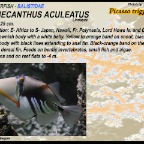Triggerfish - Balistidae
TRIGGERFISH - BALISTIDAE
Triggerfish are easy to recognize because of their laterally-compressed body, small mouth and strong teeth. Their second dorsal and anal fins reflect their shape. Their first dorsal fin has a large spine that can be held erect and locked by a second spine. This spine is used to secure themselves into crevices when in danger or sleeping. Triggerfish are active in the day and mostly live solitary or in loose groups like the redtooth triggerfish (Odonus niger). They mainly feed on hard-scaled invertebrates, sea urchins and benthic sea weeds, although some species feed on zooplankton. Triggerfish lay their eggs in nests which they make by blowing a shallow depression into a sandy bottom. These nests are mainly guarded by the females and they can be very aggressive. If approached they swim very fast towards the intruder, only turning away at the very last moment. Every intruder that comes too close will be bitten! I myself have been attacked when guiding people, although am lucky, as in many other cases people ended up with stitches. The area they protect starts from the nest going upwards in a V-shape. When having problems with an aggressive triggerfish, swim away from the nest to one of the sides and not upwards. We don’t have any information at present about their reproduction. Length: 22 cm.Distribution: from Mauritius to SW- Japan, Hawaii, Micronesia and New Caledonia.Females are completely grey-blue. Males have a grey-blueish body with a blue patch from upper lip to chin and cheeks. Yellow margins on tail, dorsal- and anal fins.Feeds on zooplankton, on outer reef slopes and walls from islands. From -15 to -20 m, mostly below -20 m. Length: 22 cm.Distribution: from E- Africa to S- Japan, Samoa, E- Australia and Lord Howe Is.From dark brown to brown-yellow, juveniles white below lateral line. Adults have blueish chin and belly. Yellow-orange vertical line, from left bottom eye-corner down. Yellow-brown tailfin with very wide white margin. Shy.Lives solitary in lagoons and seaward reefs, from -2 to -30 m. Length: 24 cm.Distribution: from E- Africa to S- Japan, Hawaii, Fr. Polynesia and Great Barrier Reef.Grey with some light-brown body, sometimes a completely white head. Two yellow or brown scythe-shaped lines behind the eyes, blue area above the eyes.Feeds on a wide variety of bentic invertebrates and algae. Prefers sandy places with rubble and many hiding places, on seaward reefs from -3 to -90 m. Length: 25 cm.Distribution: E- Africa to S- Japan, Hawaii, Fr. Polynesia, Lord Howe Is. and G.B.R.Grey-brownish body with a white belly. Yellow to orange band on snout, black areaon mid-body with black lines extending to anal fin. Black-orange band on the back towards dorsal fin. Feeds on bentic invertebrates, small fish and algae.In lagoons and on reef flats to -4 m. Length: 55 cm.Distribution: E- Africa to S- Japan, Micronesia, Polynesia, New Caledonia and G.B.R.Dark to lighter blue, light blue to rusty red margins on each fin.Juveniles are yellow with blue lines and spots, blue fins with yellow dots.Solitary, females can be very aggressive when nesting! Prefers sand and rubble areas at the base of coral reefs, in lagoons and on seaward reefs down to -50 m. Length: 60 cm.Distribution: E- Africa to S- Japan, Micronesia, Fr. Polynesia and Great Barrier Reef.Blue-greenish body with pale orange to pink snout, some dark lines underneath the eyes. Dark fins with yellow to orange margins. Feeds on corals, bentic invertebratesand tunicates. Solitary, nests in sand and rubble channels. In lagoons, coastal -and sheltered outer reefs. from -2 to -50 m. Length: 40 cm.Distribution:E- Africa to S-Japan, Micronesia, Fr. Polynesia, New Caledonia and G.B.R.Blue-greenish body with a paler head. Two blue lines going from the eyes towards themouth, red teeth. Light blue margin on tail, dorsal- and anal fin. Adults get long lobeson the tail fin. Feeds primarily on plankton, occasionally on sponges. When threate-ned, they hide into holes with the tail sticking out. On seaward reefs, from -2 to -40 m.Length: 40 cm.Distribution:E- Africa to S-Japan, Micronesia, Fr. Polynesia, New Caledonia and G.B.R.Blue-greenish body with a paler head. Two blue lines going from the eyes towards themouth, red teeth. Light blue margin on tail, dorsal- and anal fin. Adults get long lobeson the tail fin. Feeds primarily on plankton, occasionally on sponges. When threate-ned, they hide into holes with the tail sticking out. On seaward reefs, from -2 to -40 m.Length: 40 cm.Distribution: E- Africa to Galapagos, S- Japan, Hawaii, New Caledonia and Australia.Brown to black body, often with yellowish chin. Yellow pectoral fins and orange to yellow mouth. Dorsal and anal fin, white with a black margin. White tail with a broadpink margin. Solitary or in small groups, coral-rich areas of seaward reefs which areexposed to currents. From -4 to -60 m. Feeds on algae and some invertebrates. Length: 75 cm.Distribution: Red Sea to S- Japan, Micronesia, Fr. Polynesia and New Caledonia.Dark brown body with white rear body and tail base. Yellow greenish cheeks with a black moustache looking band over the snout. Dark yellow fins with a black margin.Nesting females are known to attack divers when they come to close to the nest.Feeds on corals,bentic invertebrates and algae. Among coral reefs to -50 m. Length: 50 cm.Distribution: from E- Africa to S- Japan, Samoa and Australia.Black undercolour with big white round-ish spots on lower body, yellow patch withblack dots around first dorsal fin. White to yellow band across snout, yellow mouth.Juveniles mostly in caves or other hiding places below -20 m. Among clear seaward reefs and steep slopes, from -1 to -75 m. Length: 30 cm.Distribution: from E- Africa to S- Japan, Hawaii, Tuamotu Is. and Australia.Dark to light green body with orange diagonal lines. Mature males loose the stripes onthe snout. Black spot on tail base, yellow fins and orange stripe on underlip.Feeds on corals, sponges, worms, echinoderms, crustaceans and fishes.On coral-rich areas of lagoons and seaward reefs, from -2 to -50 m.


























